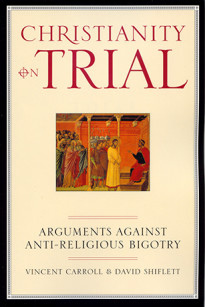As with many apologetics books, the intended audience of this seems like it might be the skeptic community when in fact it is clearly written for Christians. In other words, this is not a book that will convince skeptics but is intended to ease the worries Christians have about the God of the Old Testament.
The first clue for this comes from the title: the average skeptic will not simply call the Old Testament god a bully. This being is a moral monster — which is actually the title of another book by Copan. The subtitle gives a clearer indication of the intended audience: “Reconciling Portrayals of God in the Old and New Testaments.” This book is written for people who love the god of the New Testament (i.e., Jesus) but finds the Old Testament god a bit off-putting. This is important because Christianity declares that, appearances to the contrary, these are the same being, albeit in different “persons,” which makes no logical sense, but that’s an argument for a different review. So this is an effort to reconcile kind Jesus with the evil god of the Old Testament by trying to remove the “appearances to the contrary” part of the argument altogether.
How do I as a skeptic read it, then? I tried to give it the benefit of the doubt, I tried to “treat another’s writing as you yourself would want your own writing to be treated” (6) as Copan suggested we do with the OT text, but in the end, I was just disappointed. There were no apologetic tactics in this book I had not encountered (and dismissed) before. The primary problem with this book from a skeptical point of view is that all the moves the author makes to square the two gods of the Bible simply belie the underlying Christian contention about Biblical authorship. In other words, he relies primarily on that old tired tactic “context.” Indeed, he has an entire chapter called “A Bit of Near Eastern Context.” For example, in justifying the harsh punishments proscribed in the Old Testament, Copan brings up the exaggerations of the Code of Hammurabi and then suggests that these are merely exaggerations as well and that “it is likely that the death penalty was rarely utilized” (85). This suggests that the authors of the Old Testament merely used the same tactics as the authors of Hammurabi’s Code. Yet how could that be? Didn’t the Christian god inspire the Bible? This apologetic tactic undercuts the claims of divine authorship, but Copan has a solution, explaining that the “Mosaic law didn’t start from scratch or reinvent the wheel” and suggests that it “appropriated sources apart from any direct divine revelation to Moses, who selected and adapted material resulting in a ‘special synthesis'” (37). Just Copan never explains just what this “special synthesis” might be and how we might discern Moses’s borrowing from surrounding cultures and divine intervention.
The other primary tactic Copan uses is qualification. This might be, or that could be, or this is a logical inference, or that is implied. This is probably an exaggeration and that is probably not carried out. In other words, it’s all conjecture.
This is a book that will not convince anyone who genuinely questions the text. This is a book for Christians looking to feel better about the god of the Old Testament.
 I was drawn to this book for one reason: I grew up in the same cult as Walker, Herbert W. Armstrong’s Worldwide Church of God (WCG). Hence, as I read the book, I felt an eerie similarity with many of Walker’s experiences. His sense of otherness while at school was the same as my sense of otherness. His sense of impending doom while looking at peers in school was my sense of impending doom.
I was drawn to this book for one reason: I grew up in the same cult as Walker, Herbert W. Armstrong’s Worldwide Church of God (WCG). Hence, as I read the book, I felt an eerie similarity with many of Walker’s experiences. His sense of otherness while at school was the same as my sense of otherness. His sense of impending doom while looking at peers in school was my sense of impending doom. Do I have to actually finish a book in order to review it? Doesn’t the fact that I couldn’t bring myself to slog through another page constitute a review in and of itself?
Do I have to actually finish a book in order to review it? Doesn’t the fact that I couldn’t bring myself to slog through another page constitute a review in and of itself?






 We just got Wynton Marsalis’ latest album, From the Plantation to the Penitentiary (
We just got Wynton Marsalis’ latest album, From the Plantation to the Penitentiary (